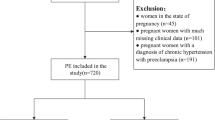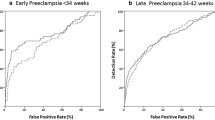Abstract
Background
This study was conducted to evaluate how the preeclampsia integrated estimate of risk (fullPIERS) model performs in the prediction of adverse maternal outcomes when the predictor variables are all obtained within 24-h of admission for preeclampsia.
Methods
A prospective cohort study on 323 women who fulfilled definite inclusion and exclusion criteria was conducted. Subjects were monitored for clinical symptoms of preeclampsia, biochemical parameters, and adverse maternal and neonatal outcomes. A risk prediction score was calculated using the fullPIERS calculator. Statistical analysis of rates and ratios was carried out by assessing χ 2 test and odds ratio.
Results
18.3 % (n = 60) had adverse maternal outcome and 42.8 % (n = 138) had adverse fetal outcome, and 43 (13.35 %) had combined adverse maternal and perinatal outcome. Dyspnea, visual disturbances, epigastric pain, and \( {\text{Sp}}_{{{\text{O}}_{2} }} \) appeared to be highly significant risk factors. In the biochemical variables studied, serum creatinine and serum uric acid were found to have a significant association. The association between adverse perinatal outcome and vaginal delivery was highly significant (OR 0.35, 95 % CI 0.19, 0.63), and the P value was 0.0005. The likelihood ratio associated with the highest risk group (predicted probability of the outcome ≥30 %) showed excellent performance (i.e., 17.5) of fullPIERS model as a rule in test.
Conclusion
The fullPIERS model performed well in the prediction of adverse maternal outcomes in women with preeclampsia. It is easy to use. The model is based on the use of few important clinical and biochemical parameters and does not require extensive laboratory testing. Although it might be of limited use in a well-equipped tertiary care facility, this model can be utilized in the setting of district or sub-district level hospitals to identify patients who are at risk of complications due to preeclampsia. Timely referral to a higher center will help in reducing the morbidity and mortality associated with this condition.
Similar content being viewed by others
References
von Dadelszen P, Payne B, Li J, et al. Prediction of adverse maternal outcomes in preeclampsia: development and validation of the fullPIERS model. Lancet 2011;15:219–27.
Steegers EAP, von Dadelszen P, Duvekot JJ, et al. Preeclampsia. Lancet. 2010;376:631–44.
Menzies J, Magee LA, Macnab YC, et al. Current CHS and NHBPEP criteria for severe preeclampsia do not uniformly predict adverse maternal or perinatal outcomes. Hypertens Pregnancy. 2007;26:447–62.
Magee LA, Helewa ME, Moutquin JM, et al. Diagnosis, evaluation, and management of the hypertensive disorders of pregnancy. SOGC Clinical Practice Guidelines, No. 206, March 2008. J Obstet Gynaecol Can. 2008;30(Suppl 3):S1–48.
American College of Obstetricians and Gynecologists Committee on Practice Bulletins—Obstetrics. Diagnosis and management of preeclampsia and eclampsia. ACOG Practice Bulletins, No. 33, January 2002. Obstet Gynecol. 2002;99:159–67.
Payne B, Hodgson S, Hutcheon J, et al. Performance of the fullPIERS model in predicting adverse maternal outcomes in pre-eclampsia using patient data from the PIERS (Pre-eclampsia Integrated Estimate of Risk) cohort, collected on admission. BJOG. 2013;120:113–8.
Thangaratinam S, Coomarasamy A, O’Mahony F, et al. Estimation of proteinuria as a predictor of complications of pre-eclampsia: a systematic review. BMC Med. 2009;7:10.
Pre-eclampsia Integrated Estimate of RiSk (PIERS). http://piers.cfri.ca/PIERSCalculatorH.aspx. Accessed 13 Sept 2015.
Thangaratinam S, Gallos ID, Meah N, et al. How accurate are maternal symptoms in predicting impending complications in women with preeclampsia? A systematic review and meta-analysis. Acta Obstet Gynecol. 2011;90(6):564–73.
Yen T-W, Payne B, Qu Z, et al. Using clinical symptoms to predict adverse maternal and perinatal outcomes in women with preeclampsia: data from the PIERS (Pre-eclampsia Integrated Estimate of RiSk) Study. J Obstet Gynaecol Can. 2011;33(8):803–9.
Kozic JR, Benton SJ, Hutcheon JA, et al. Abnormal liver function tests as predictors of adverse maternal outcomes in women with preeclampsia. J Obstet Gynaecol Can. 2011;33(10):995–1004.
Thangaratinam S, Ismail K, Sharp S, et al. Accuracy of serum uric acid in predicting complications of pre-eclampsia: a systematic review. BJOG. 2006;113:369–78.
Hawkins T, Roberts J, Mangos G, et al. Plasma uric acid remains a marker of poor outcome in hypertensive pregnancy: a retrospective cohort study. BJOG. 2012;119:484–92.
Payne B, Magee LA, Cote A-M, et al. PIERS proteinuria: relationship with adverse maternal and perinatal outcome. J Obstet Gynaecol Can. 2011;33(6):588–97.
Coopmans CM, Bijlenga D, Groen H, et al. Induction of labour versus expectant monitoring for gestational hypertension or mild pre-eclampsia after 36 weeks’ gestation (HYPITAT): a multicentre, open-label randomised controlled trial. Lancet. 2009;374(9694):979–88. doi:10.1016/S0140-6736(09)60736-4.
Alanis MC, Robinson CJ, Hulsey TC, et al. Early-onset severe preeclampsia: induction of labor vs elective cesarean delivery and neonatal outcomes. Am J Obstet Gynecol. 2008;199:262.e1–6.
Seal SL, Ghosh D, Kamilya G, et al. Does route of delivery affect maternal and perinatal outcome in women with eclampsia? A randomized controlled pilot study. Am J Obstet Gynecol. 2012;206:484.e1–7.
Author information
Authors and Affiliations
Corresponding author
Ethics declarations
Conflict of interest
Dr. Shruti Agrawal has no conflict of interest, and Dr. Nandita Maitra has no conflict of interest.
Informed Consent Disclosure
All procedures followed were in accordance with the ethical standards of the Responsible Committee on Human Experimentation (Institutional and National) and with the Helsinki Declaration of 1975, as revised in 2008 (5).
Additional information
Shruti Agrawal is a Third-Year Resident; Nandita Maitra is a Professor and Head.
Electronic supplementary material
Below is the link to the electronic supplementary material.
Rights and permissions
About this article
Cite this article
Agrawal, S., Maitra, N. Prediction of Adverse Maternal Outcomes in Preeclampsia Using a Risk Prediction Model. J Obstet Gynecol India 66 (Suppl 1), 104–111 (2016). https://doi.org/10.1007/s13224-015-0779-5
Received:
Accepted:
Published:
Issue Date:
DOI: https://doi.org/10.1007/s13224-015-0779-5




